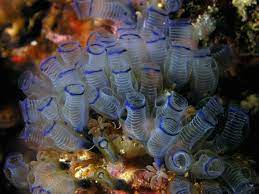Tunicate Fossil Species:

Researchers described a 500-million-year-old tunicate fossil species, which suggested that the modern tunicate body plan was already established soon after the Cambrian Explosion.
- The new fossil, named Megasiphon thylakos, revealed that ancestral tunicates lived as stationary, filter-feeding adults and likely underwent metamorphosis from a tadpole-like larva.
- These are commonly called sea squirts which are a group of marine animals.
- They spend most of their lives attached to docks, rocks or the undersides of boats.
- About 3,000 species of tunicate exist in the world’s oceans, living mostly in shallow water.
- They are a species of marine invertebrates with an evolutionary history from at least 500 million years ago.
- Researchers are interested in them as they are the closest relatives of vertebrates, which includes fish, mammals, and people.
- There are two main tunicate lineages namely;
- Ascidiaceans: They are often called “sea squirts and most ascidiaceans begin their lives looking like a tadpole and mobile, then metamorph into a barrel-shaped adult with two siphons. They live their adult life attached to the seafloor.
- Appendicularias: They retain the look of a tadpole as they grow to adults and swim freely in the upper waters.
- These seem extremely far removed from vertebrates.




